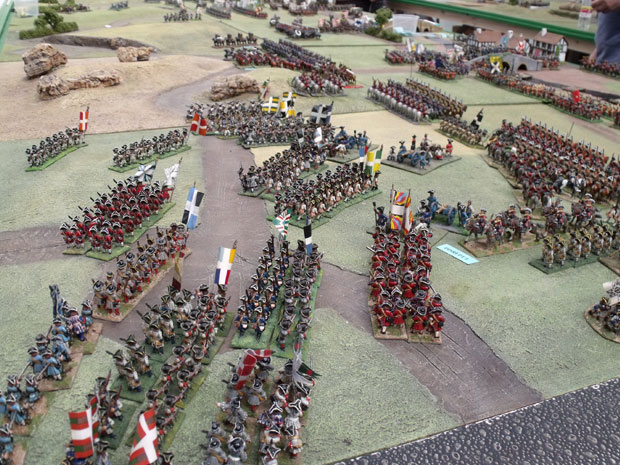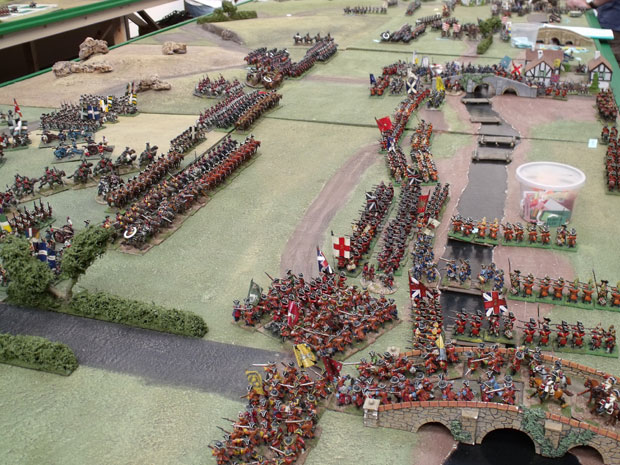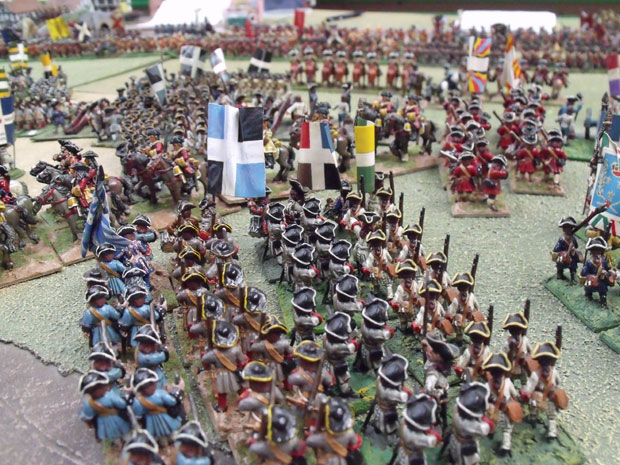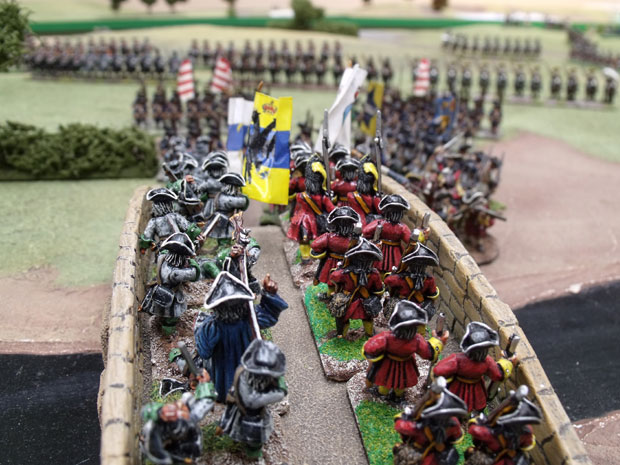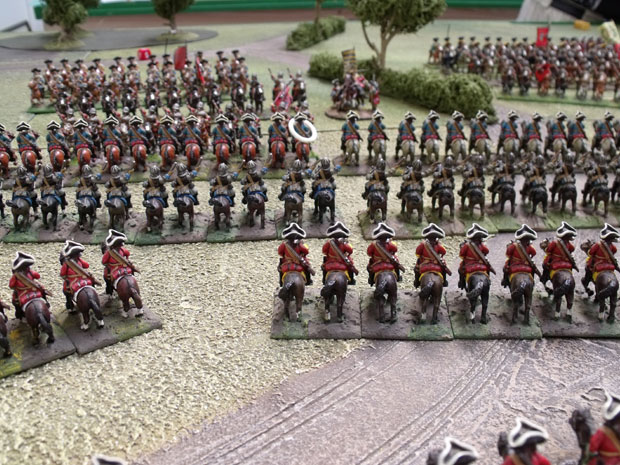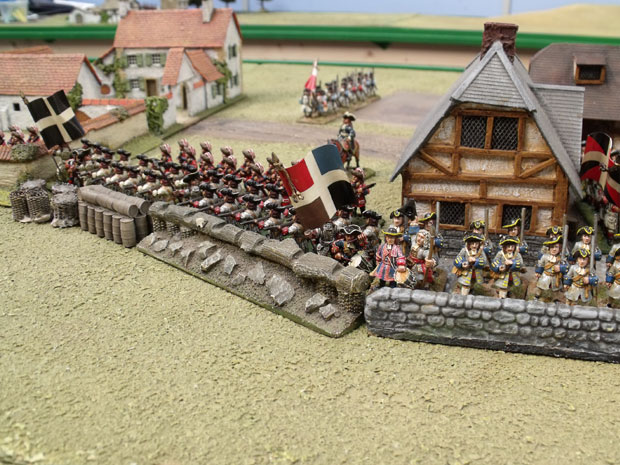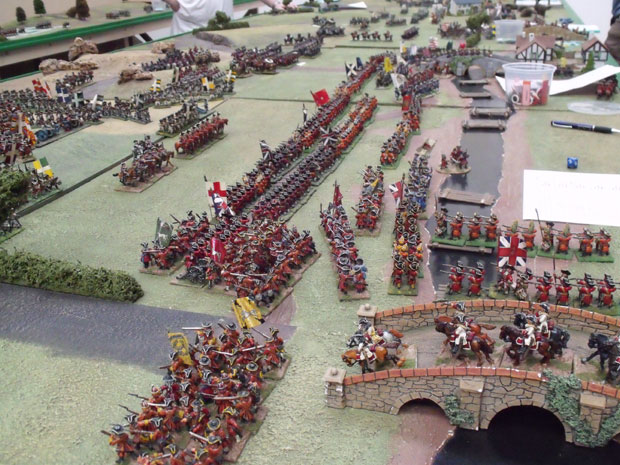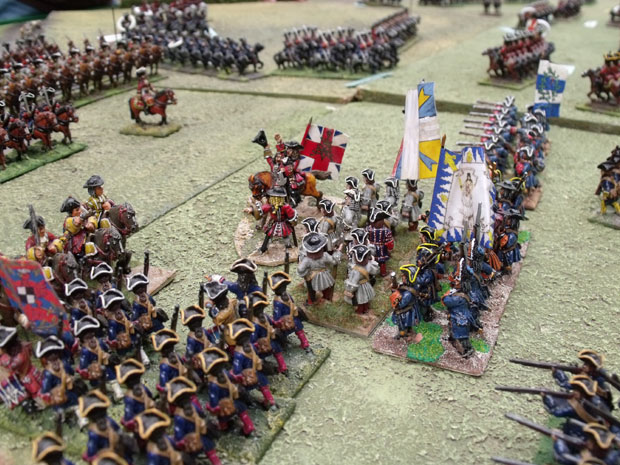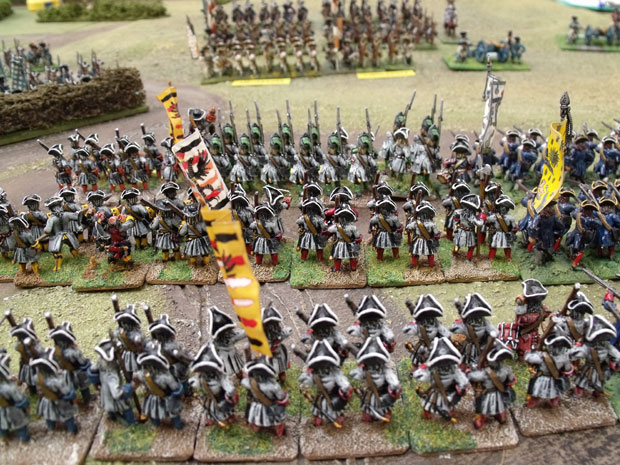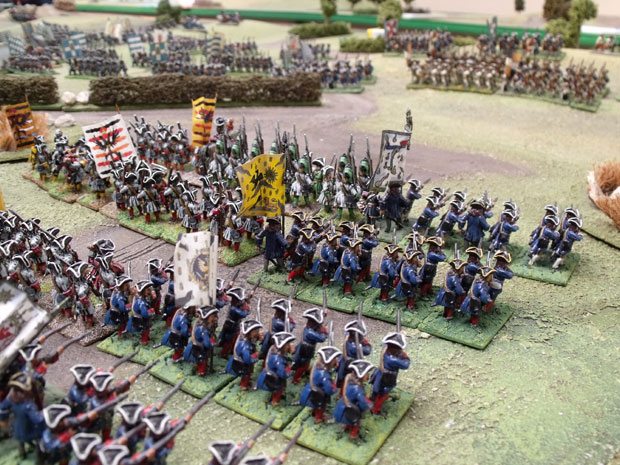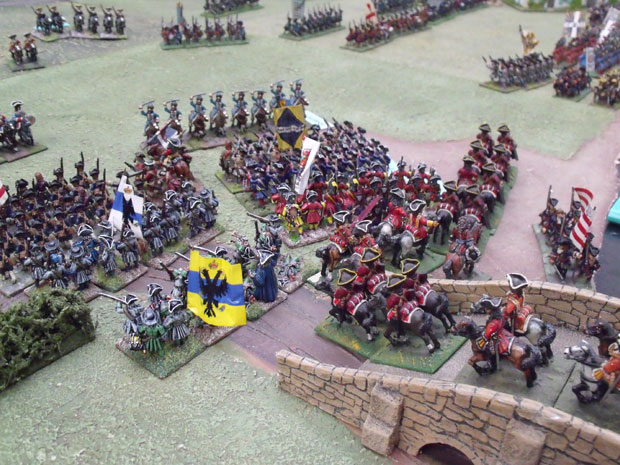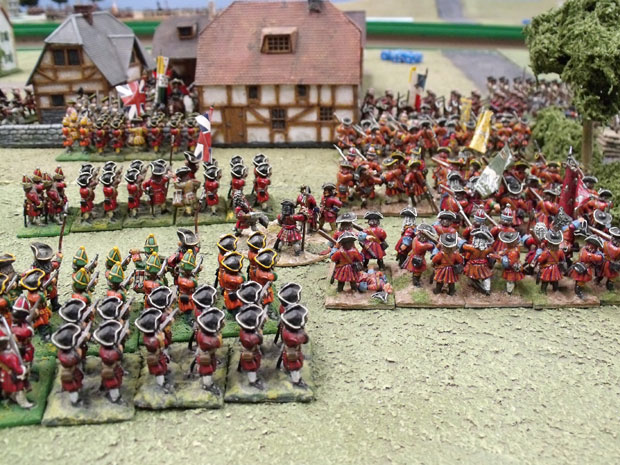The Battle of Blenheim was our first Marlburian re-play at the Wargames Holiday Centre. I was quite excited at the prospect. The test games had offered a smooth playable game with a hell of a lot of accuracy. I couldn’t wait.
The battlefield was laid out in detail, the Nebel Stream, the villages of Blenheim, Oberglau and Unterglau were all in place. All we needed was a team of guys to play the parts of the commanders.
Taken early Sunday morning, the view of the battle from the river Danube, Blenheim is in the foreground.
This weekend proved to be a little special, one of the team members had been away from the hobby for over thirty years and was a little concerned that he may need a bit more experience in gaming before coming along. He was the first person to turn up, so I went through some of the basics of the rules (thankfully he is quite experienced in the period so all the concepts were readily accepted and appreciated). We set about writing the tiles out for the various regiments. Once all the tiles were written it was time to decide on the strategy to win the day.
The French infantry manoeuvre into position to hold the line west of Blenheim.
The British and their allies deployed as they were historically, Cutts deployed in front of Blenheim, Ingoldsby, Blood, Orkney and Churchill in the Centre, supported by Bulow and Rantzau with their respective cavalry formations, on the allied right Eugene of Savoy deployed with a mix of Swabian, German, Dutch and Prussian troops.
Cutt’s brigade deploys in force over the Nebel stream.
The French were restricted in their deployment, Tallard and Clerambault deployed behind and in and around Blenheim. The French Cavalry held the Centre while the Elector of Bavaria held the French left flank opposite Eugene of Savoy.
The French under Marshal Tallard look to replace their cavalry in the battle line.
The first turn saw the British and Hanoverian Cavalry under Rantzau and Cutts advance toward the Nebel to drop Fascines into the stream to help get their infantry across. The artillery deployed opposite Blenheim and in the centre and opened fire.
Cutt’s brigade is halted by the repeated charges of the French Gendarmes.
The French, roused from their camps were a little slow to get going, but once the activity of the Allies in their crossing of the Nebel was appreciated their cavalry swarmed forward to hinder the crossing of the stream.
Swabian foot advance early in the battle, using a bridge to deploy quickly across the Nebel Stream.
The cavalry on the allied right wing under Eugene galloped forward in an attempt to drive the supporting troops back from around Oberglau and the woods surrounding it. The Austrian Cuirassier under the Prince of Hanover charged into the Bavarian Carabinier on the far right of Eugene’s position. They were met at the halt and received a volley at short range from the pistols of the Carabiniers. The resulting melee saw the Cuirassier retire to re-group.
Bavarian cavalry move to engage Prince Eugenes forces, early in the battle.
A battalion of the Bavarian Lieb Guard were in the village of Oberglau and they prepared their position in readiness for the impending assault. The Saxon Garde obliged and fired a volley at effective range and then charged into the village. The brave Bavarians were facing out of an adjacent side of the village and could not fire a volley at these chargers, in the melee they held on though and the Saxons had to retire. Three times the Saxons charged back into the village and three times they were repulsed. After a while the Bavarians re-inforced the village with a couple of regiments of Bavarian line.
Bavarian infantry move into Oberglau to support the 3rd Lieb Battalion.
Surely it would be impossible now.
Austrian Hussars emerge from the woods on the flank of the Bavarians, looking to break the deadlock..
Meanwhile over on the French right in Blenheim, Clerambault panicked and threw four more battalions into Blenheim, much to the annoyance of their commander. The rest of the force however managed to by pass the village and took up position on the high ground just opposite the Nebel stream, where Cutts brigade was crossing.
The French heavily ensconced within the streets of Blenheim.
The French cavalry had dashed forward to engage any troops crossing the Nebel, which slowed down the British and Hanoverians deployment somewhat from in front of Blenheim toward the centre of the battle near the village of Unterglau, the whole area was cautiously advancing.
Cutt’s Brigade begins it’s advance.
The Hessians and Palatinate troops rolled forward however, they were not impeded by the stream so much to their front, allowing a free movement, driving volley after volley into the French cavalry that had looked to delay them.
Ingoldsby’s German’s push on, firing repeated volleys in an effort to clear the French cavalry.
Marlborough was everywhere urging his troops on!
The reserve of Bulow and Rantzau awaited their moment, positioned behind the main Allied army. Cutts was making slow progress and the crossing of the Nebel caused a certain amount of disruption. Most of the brigade was across the stream now, but to little gain as the French infantry were now replacing their cavalry in the line and the exchange of volleys picked up a pace. Orkney and Ingoldsby took their place in the line linking up Cutts brigade with Eugene’s wing.
Prince Eugene’s troops move in to support the attack on Oberglau, these troops tied up a lot of the support going to Oberglau.
The British and Hanoverian infantry of Cutts Brigade formed lines of battle three and four battalions deep and stepped forward. On their right came Orkneys British Battalions and then Ingoldsby’s Hessians and Palatinates, to their right were the Saxons, Swabians, Prussians and Dutch of Eugenes force.
The view from Eugenes wing.
The French Horse, Cuirassier du Roi and Gendarmes took up position to further delay the advance and began exchanging shots with the advancing lines. They really needed to delay the advancing British to allow their infantry to deploy.
The Hanoverians, supported by a battalion of the British Guards moved on Blenheim, another two French Battalions were fed into Blenheim. The volleys erupted all along the line.
The British and Hanoverians deploy before Blenheim.
Over on the Electors front, Oberglau was hotly contested, there were now three battalions in the village and the Prussians and Saxons were taking a heavy toll on them. Still they hung on though. The whirling mass of cavalry on the far flank of this part of the battlefield continued to charge, take fire and then retire, regroup and go again! Eugenes troops were having a tough time in breaking the Bavarian wing.
The Germans of Prince Eugene advancing into the Maelstrom!
Toward late afternoon it was decided to commit Cutts cavalry regiments to the centre and try to turn the Bavarian right, this would cause a hole to appear, the only troops linking the French with the Bavarians were the Bavarian cavalry
The British horse from Cutt’s brigade deploys in support of Ingoldsby, they would be smashing into the Bavarian flank shortly.
Time for the pub now though, a well earned pint and a meal while the finer points of the day were discussed.
Sunday morning, bright eyed and bushy tailed the swords were picked up again and the Allies renewed their attack. The artillery bombardment of Blenheim was proving useless, so it was agreed that the Hanoverians would have to drive the French out, the down side was that their were a lot of French in the village now, so it was going to be tough work.
A view of the battlefield early on the Sunday morning, just before the commanders arrived.
Cutts cavalry reached a bridge across the Nebel and began crossing, this wasn’t unnoticed by the French high command and they began extricating their own cavalry and moving to engage this new threat.
Rantzau was also moved up to support the central advance, the Danish Cuirassier eyeing the new formations of French infantry and artillery. British Horse moved up to the stream and began to cross.
Along the whole front the volleys started again, Frenchmen began to fall at an alarming rate as the British began closing the distance to a short range contest! Some of the battalions proved a little eager and settled into firefights at long and effective range and only the commanders themselves could resolve the problem, urging the troops to close the range.
The British lines close with the French into short range, a lot of casualties were given and receivd throughout this action, the lines being withdrawn and replaced by fresh ones all to no avail.
The Bavarians had began something of a counter attack, the casualty rate had proved quite high though, even to the point where some of their Land (militia) regiments were now nearing the front lines. The cavalry battle on the very far wing here continued a pace, all the cavalry had now been in action and suffered thirty to forty percent casualties.
Cutt’s cavalry had made the crossing and charged into the Bavarian cavalry holding the centre, if this was lost the French would be split from the Bavarian allies, the flanks would be exposed and all could be lost. The Bavarians stood their ground, gave fire and held the British Horse off! The British retired, regrouped and looked to assault again.
In the Centre of the battlefield the main French and British armies stood toe to toe, mostly at short range and blew great swathes of the battalions down! Nothing gave though, the Wing command of Eugene and the Elector had worn each other down, the Bavarians keeping their position and the upper hand.
The British infantry of Cutt’s brigade tried several attempts at charging the French line only to be repulsed, while the Cavalry of Cutt’s brigade again charged the Bavarian cavalry, looking to drive a wedge between the two armies. Six regiments of British Horse and Dragoon charged again and again, but the stalwart Bavarians held their ground.
The Danish Cuirassier and British Horse filed past the Battle lines of the British infantry and deployed into line. Fire from the French emptied a few saddles, but it proved ineffective at long range. When they were ready they charged forward into the Guns and French Battalions, the fire was poor from the French, only one or two figures were lost and the cavalry smashed into the French, cutting one French battalion down to a stand, they broke and ran! The second line of infantry remained stalwart though. The second wave of cavalry smashed into the line, a hammer blow to break the back of the French battle line, the fire was better this time, one regiment of Horse losing forty percent of it’s men. On they went, into the French infantry, in the ensuing melee the second line of Frenchmen fared better than the first, they were fresher I suppose and the cavalry fell back and looked to reform.
The British horse from Rantzau’s command advance in support of the charging Danish Cuirassier.
On the Allied far left in front of Blenheim the British and Hanoverians were now in position to push forward on to Blenheim. The French held their fire until the last minute and shot away twenty five percent of the front battalions, still the British advanced and returned the volley. Then they charged, into the streets of Blenheim the hand to hand fighting was bloody. The British looked to their Hanoverian counterparts for support but the luckless Germans broke and fled, leaving the British battalions alone and outnumbered.
The British and Hanoverian infantry charge into the streets of Blenheim, after some bitter fighting the Hanoverians broke, the british were left with no other option than to retire.
Eventually the British had to retire from the village, they reformed ready for another assault but it was felt that the Allies had lost their chance, the battle was lost and the army began to retire in good order. The French had held the field, the Bavarians had held but suffered huge casualties, I suppose that this would have taken them out of future campaigning. The British and Allied cavalry was still in good condition
Another day perhaps.


